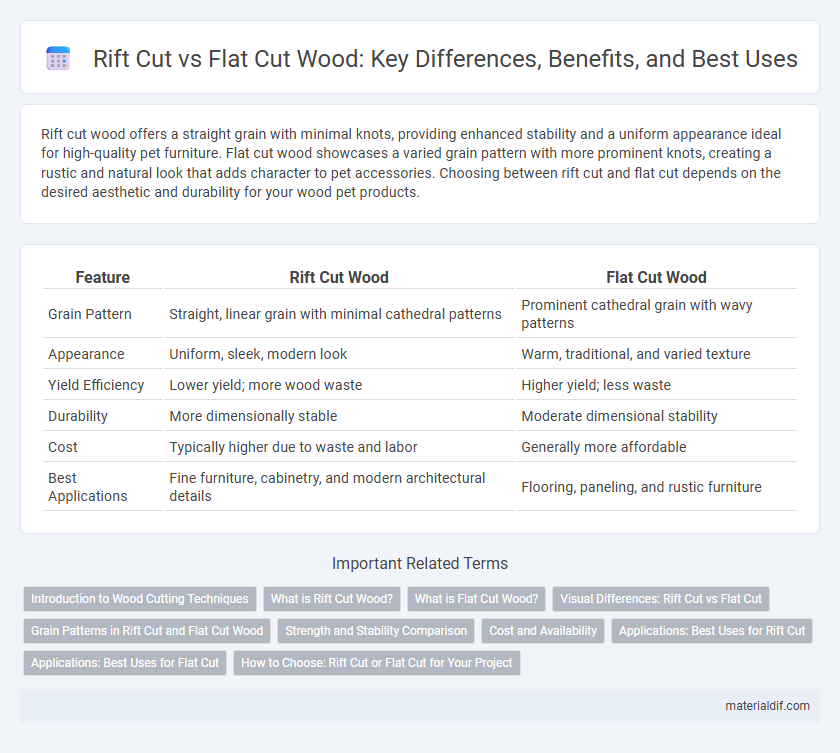Rift cut wood offers a straight grain with minimal knots, providing enhanced stability and a uniform appearance ideal for high-quality pet furniture. Flat cut wood showcases a varied grain pattern with more prominent knots, creating a rustic and natural look that adds character to pet accessories. Choosing between rift cut and flat cut depends on the desired aesthetic and durability for your wood pet products.
Table of Comparison
| Feature | Rift Cut Wood | Flat Cut Wood |
|---|---|---|
| Grain Pattern | Straight, linear grain with minimal cathedral patterns | Prominent cathedral grain with wavy patterns |
| Appearance | Uniform, sleek, modern look | Warm, traditional, and varied texture |
| Yield Efficiency | Lower yield; more wood waste | Higher yield; less waste |
| Durability | More dimensionally stable | Moderate dimensional stability |
| Cost | Typically higher due to waste and labor | Generally more affordable |
| Best Applications | Fine furniture, cabinetry, and modern architectural details | Flooring, paneling, and rustic furniture |
Introduction to Wood Cutting Techniques
Rift cut wood features vertical grain patterns achieved by cutting logs radially, providing enhanced dimensional stability and a consistent straight grain ideal for fine furniture and flooring. Flat cut wood, also known as plain sawn, displays a varied grain pattern with cathedral shapes, maximizing yield from the log but offering less uniformity and stability. Selecting between rift cut and flat cut techniques depends on the desired aesthetic, durability, and application requirements in woodworking projects.
What is Rift Cut Wood?
Rift cut wood is produced by cutting logs at a precise angle between 30 to 60 degrees to the growth rings, resulting in straight, vertical grain patterns with minimal medullary rays. This type of cut provides enhanced dimensional stability and a uniform appearance, making it ideal for fine woodworking and cabinetry. Rift cut lumber typically exhibits less warping and cupping compared to flat cut wood, making it a preferred choice for high-quality furniture and flooring.
What is Flat Cut Wood?
Flat cut wood, also known as plain sawn, is produced by slicing the log tangentially to the growth rings, creating a distinctive cathedral grain pattern on the board surface. This method maximizes yield and results in a wood appearance characterized by broad grain lines and natural variations. Flat cut wood is commonly used for furniture, flooring, and paneling due to its cost-effectiveness and visually appealing grain.
Visual Differences: Rift Cut vs Flat Cut
Rift cut wood features straight, linear grain patterns with minimal flecking, creating a clean, consistent appearance ideal for modern interiors. Flat cut wood displays more varied grain patterns, including cathedral or flame-shaped figures, offering a richer, more pronounced visual texture. Choosing between rift cut and flat cut depends on the desired aesthetic, whether uniformity or natural character is prioritized in wood surfaces.
Grain Patterns in Rift Cut and Flat Cut Wood
Rift cut wood showcases a straight, tight, and linear grain pattern, resulting from cutting perpendicular to the growth rings, which enhances uniformity and visual consistency. Flat cut wood, also known as plain sawn, reveals a more dramatic, cathedral or flame grain pattern due to slicing tangentially to the growth rings, highlighting contrast and natural wood character. Rift cut grain is preferred for modern, clean designs, while flat cut grain suits traditional and rustic aesthetics, impacting both appearance and application.
Strength and Stability Comparison
Rift cut wood features a quartered grain pattern that enhances dimensional stability by minimizing warping and cupping, making it stronger under structural stress compared to flat cut wood. Flat cut wood presents a cathedral grain pattern that is more prone to expansion and contraction due to moisture changes, reducing its overall stability. For applications requiring superior strength and resistance to environmental changes, rift cut wood is the preferred choice.
Cost and Availability
Rift cut wood typically costs more than flat cut due to its labor-intensive cutting process, which results in higher waste and limited yield. Flat cut wood is more widely available and budget-friendly, making it preferable for large-scale projects requiring consistency and cost efficiency. The demand for rift cut wood in premium applications influences its price and availability in the market.
Applications: Best Uses for Rift Cut
Rift cut wood is prized for its straight grain pattern and dimensional stability, making it ideal for applications requiring precision and durability such as fine furniture, cabinetry, and high-end flooring. Its uniform appearance and resistance to warping also suit architectural millwork and stair treads where consistent aesthetics are crucial. Compared to flat cut wood, rift cut minimizes expansion and contraction, ensuring longevity in hardwood installations.
Applications: Best Uses for Flat Cut
Flat cut wood is ideal for applications requiring broad, uniform grain patterns that enhance the visual appeal of furniture, cabinetry, and interior paneling. Its decorative appeal is particularly suited for veneers and architectural millwork, where the consistent grain adds warmth and elegance to living spaces. This cut also performs well in flooring, providing a balanced, classic look that complements a variety of design styles.
How to Choose: Rift Cut or Flat Cut for Your Project
Rift cut wood offers a consistent grain pattern with minimal cathedrals, making it ideal for modern or minimalist designs where uniformity enhances aesthetics. Flat cut wood displays more varied and pronounced grain patterns, providing character and warmth suited for traditional or rustic projects. Choose rift cut for sleek, linear visuals and flat cut to showcase natural, dynamic grain textures in your woodworking project.
Rift Cut vs Flat Cut Infographic

 materialdif.com
materialdif.com